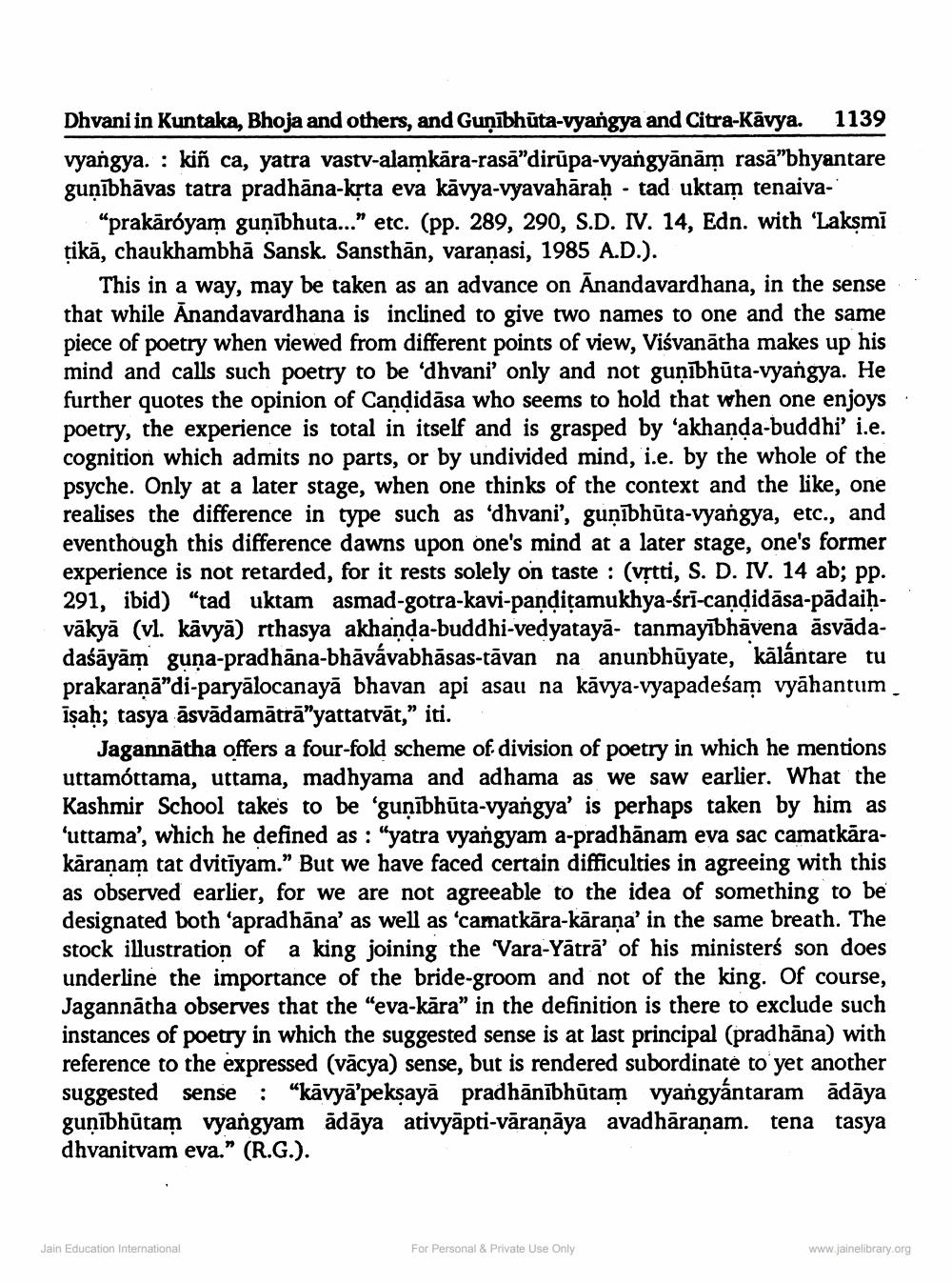________________
Dhvani in Kuntaka, Bhoja and others, and Guņībhūta-vyangya and Citra-Kavya. vyangya. kiñ ca, yatra vastv-alamkāra-rasā”dirūpa-vyangyānām rasā"bhyantare guṇībhāvas tatra pradhāna-kṛta eva kāvya-vyavahāraḥ tad uktam tenaiva"prakāróyam guṇībhuta..." etc. (pp. 289, 290, S.D. IV. 14, Edn. with 'Laksmi țikā, chaukhambhā Sansk. Sansthan, varaṇasi, 1985 A.D.).
This in a way, may be taken as an advance on Anandavardhana, in the sense that while Anandavardhana is inclined to give two names to one and the same piece of poetry when viewed from different points of view, Viśvanatha makes up his mind and calls such poetry to be 'dhvani' only and not guṇībhūta-vyangya. He further quotes the opinion of Candidāsa who seems to hold that when one enjoys poetry, the experience is total in itself and is grasped by 'akhanda-buddhi' i.e. cognition which admits no parts, or by undivided mind, i.e. by the whole of the psyche. Only at a later stage, when one thinks of the context and the like, one realises the difference in type such as 'dhvani', guṇībhūta-vyangya, etc., and eventhough this difference dawns upon one's mind at a later stage, one's former experience is not retarded, for it rests solely on taste: (vṛtti, S. D. IV. 14 ab; pp. 291, ibid) "tad uktam asmad-gotra-kavi-panditamukhya-śrī-candidāsa-pādaiḥvākyā (vl. kävyä) rthasya akhanda-buddhi-vedyataya- tanmayībhāvena āsvādadaśāyām guna-pradhana-bhāvávabhāsas-tāvan na anunbhūyate, kälántare tu prakaraṇā"di-paryalocanaya bhavan api asau na kavya-vyapadeśam vyāhantum īṣaḥ; tasya āsvādamātrā”yattatvāt," iti.
1139
Jagannatha offers a four-fold scheme of division of poetry in which he mentions uttamóttama, uttama, madhyama and adhama as we saw earlier. What the Kashmir School takes to be 'gunībhūta-vyangya' is perhaps taken by him as 'uttama', which he defined as: "yatra vyangyam a-pradhānam eva sac camatkārakāraṇam tat dvitiyam." But we have faced certain difficulties in agreeing with this as observed earlier, for we are not agreeable to the idea of something to be designated both 'apradhana' as well as 'camatkara-kāraṇa' in the same breath. The stock illustration of a king joining the 'Vara-Yatra' of his ministers son does underline the importance of the bride-groom and not of the king. Of course, Jagannatha observes that the "eva-kara" in the definition is there to exclude such instances of poetry in which the suggested sense is at last principal (pradhāna) with reference to the expressed (vācya) sense, but is rendered subordinate to yet another suggested sense : "kāvyā'pekṣayā pradhānībhūtam vyangyántaram ādāya guṇībhūtam vyangyam ādāya ativyāpti-vāraṇāya avadhāraṇam. tena tasya dhvanitvam eva." (R.G.).
Jain Education International
For Personal & Private Use Only
www.jainelibrary.org




